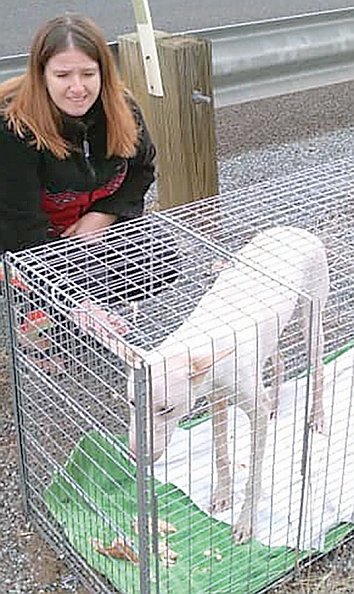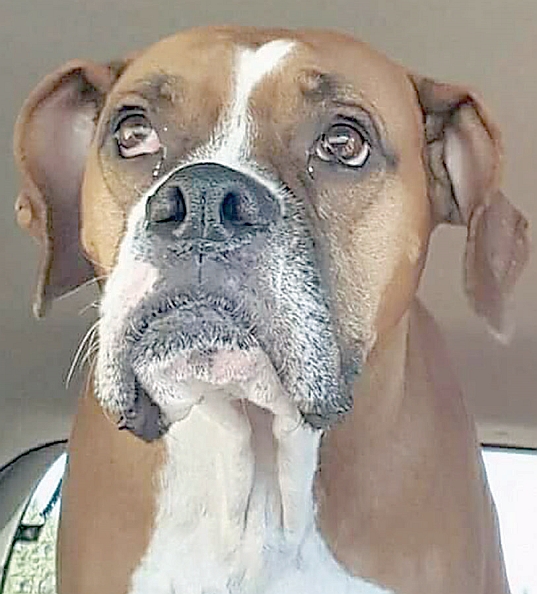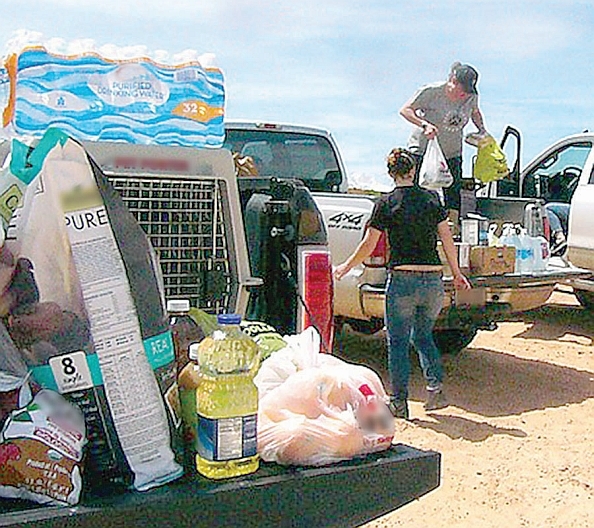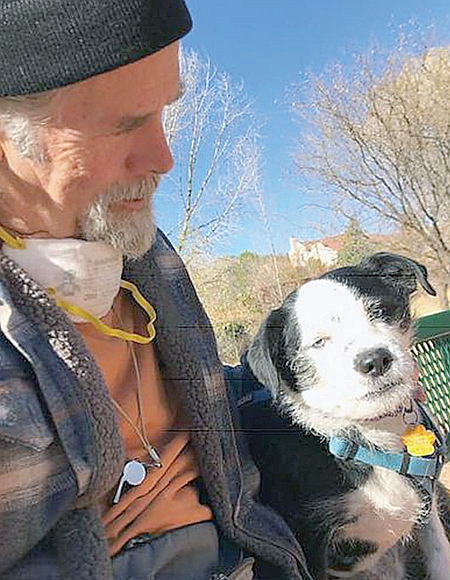By Jacqueline Vaughn
You’ve seen their photos attached to street signs, bulletin boards, and handmade signs. Another dog or cat is lost in someone’s neighborhood. Many of them do make their way back to their owners, but have you ever wondered how the process of finding and reuniting them works?
“Rescue, Foster, Adopt” is the mantra of animal welfare groups, who repeat these three words so often they are imprinted on their volunteers’ brains, it seems. But there are several groups and individuals in Northern Arizona that go beyond the mantra to include activities like trapping, search and rescue, and even more by helping to support the communities they serve.
Central Arizona Animal Search and Rescue (CAASR), based in the Camp Verde/Rimrock area, epitomizes how non-profits can evolve to focus on a specific service area. The organization, led by founder Mitzie Christian, started about 12 years ago with the purpose of reuniting lost animals and their owners.

From searching, rescuing, and trapping animals in the Verde Valley area and elsewhere, the group now has an air-conditioned and heated building with six kennels, an outside play yard for animals, outside kennels, agility equipment, and plastic pools for cooling off during the warm Arizona summer. Over time, CAASR began to grow to deal with all the “found” animals that needed to be rescued and became the foundation for training more volunteers seeking to learn the tricks of the search and rescue trade.
Some of those volunteers then founded Northern Arizona Animal Search and Rescue (NAASR) to serve the region surrounding the Flagstaff area. They started from an October 2016 effort led by volunteer Teresa Taggart to help find Vallie, a large brown and white female Boxer that went missing near Flagstaff after a car accident on Interstate 17 that killed her young owner.
Volunteers and the family of the dog’s owner thought at first that she might have been picked up by a driver who saw her running down the interstate or nearby, and efforts were expanded to check shelters outside the area in case she had been dropped off by a Good Samaritan.

The group, Bring Vallie Home, started a Facebook page for tips and ideas, including one theory that she had been stolen by someone familiar with the Kachina Village area where she was sighted.
A large reward was offered for information, trail cameras and feeding stations were set up, and a psychic as well as an animal communicator from the United Kingdom were consulted. But even though she was microchipped and there were posters put up everywhere nearby, she still has not been found. The Facebook page remains live, and others who have lost animals post there, as well as stories of animals reunited with their owners after years of searching.
Taggart started NAASR using her training from CAASR, and like that group, their work has expanded far more than even she perhaps could have envisioned. The group still has a substantial commitment to search and rescue for lost dogs, and they continue to keep looking for an animal until the owner tells them to stop, she says. “We do not have a deadline, and none of us have private lives any more. We stop what we’re doing at the drop of a hat, and we’re prepared to camp out and spend the night outdoors when we need to do so.”
She adds that “our volunteers are crazy.” They receive on the job training, and some dogs require weeks before they are trapped and found. They rely upon donations to purchase the traps and other equipment needed, and adoption fees help offset some of their costs.
Unlike CAASR, which has a facility of its own, NAASR relies on foster homes and animal shelters and veterinarians in the area when animals are initially rescued. The rescue part can be daunting in areas like the Navajo Nation, where last year a drone was used to help guide a curious puppy back to the area where searchers were waiting.

The search and rescue groups are unusual in the animal welfare world because they often cooperate rather than compete with one another. The drama is in finding an animal. Recently, for example, Patty Aiken of CAASR helped load up her car to take supplies that NAASR had purchased out to the Navajo Nation, joining volunteers from the Coconino Humane Association and friends of Taggart.
Despite its name, another local group, Yavapai Humane Trappers Animal Search and Rescue (known as YHT), has volunteers from throughout northern Arizona, and its efforts cover territory ranging from Ash Fork and Chino Valley to Kayenta and Chinle on the Navajo Nation.
The group often finds litters of puppies abandoned in culverts or alongside the roadway, and dispatches its volunteers to check out stray animals reported to the group. Recently, they responded to a homeless man and his dog and helped find transportation, food, and supplies for him—a project slightly different from the typical search and rescue event.
Less visible but equally active and critically important are “independent” search and rescuers and trappers like Kirk Landauer. He and several other local residents prefer to work on their own, using their skills and time to stake out the area where a pet was last seen, often camping out, staying in their vehicles for hours, or driving repeatedly through a neighborhood.

Originally from Maryland, Landauer grew up in the rural countryside where “everyone had critters and their critters were constantly getting lost,” he says. Many residents owned dogs for hunting, and it was typical for a dog to run fast and far, getting lost, and then eventually trapped.
He also worked for awhile with the TNR (trap, neuter, return) of feral cats. Later in life, he often came to Sedona and visited his family in Arizona where they had retired, becoming a full time resident in 2013. He now volunteers at the Humane Society of Sedona three days a week, and the rest of his life is focused on search and rescue.
Independent rescuers pay for their own fuel and other vehicle costs, buy traps and field cameras, and are generally available 24/7 when they hear an animal has gone missing.
“We do our own thing,” he says, “I’m a maniac when it comes to a missing dog. I know what it’s like to lose a dog, and I will do anything to try to find one. Last year, he continued to look for a Chihuahua named Enzo that went missing in West Sedona, long after other rescuers had given up on finding him. The dog was never recovered.
He was also a key player in finding Bonny, a dog that ran from her owners in the Kachina neighborhood of Sedona. “She was very elusive,” Landauer says, despite sightings over the course of 30 days before she was trapped.
Some equipment was stolen while rescuers attempted to find Bonny, and a local resident set up a Go Fund Me page to replace the traps and cameras that were taken and buy new equipment.
Landauer often accompanies some of the women who volunteer as an added element of protection when they are searching, and notes that search and rescue is not without costs. He spends an average of $20 a day on gasoline while searching; the tires on his vehicle and his brakes need to be replaced.
He speaks of the emotions that can accompany this type of volunteer effort. “I try not to get too depressed about humanity. You gotta do what you can. I enjoy helping those that can’t help themselves, and not focus on the people whose intentions are not always good ones.”
Sometimes the rewards are almost immediate, as was the case with a black dog seen wandering near a local Sedona restaurant wearing a collar and trailing a broken leash. Landauer was able to capture the dog, which was immediately reunited with its owner.
What the groups and individuals have in common is a desire to go beyond just rescuing animals but also helping the communities they serve. NAASR has, for instance, been successful in building relationships with the Navajo people who have been profoundly affected by the COVID-19 epidemic. Their volunteers frequently deliver supplies ranging from food to surgical masks, cleaning supplies, pet food, and other items to families they have gotten to know while looking for missing dogs on the reservation.
Taggart notes that many people are no longer working, or don’t have the $25 it would take to drive to Flagstaff to go shopping. Many others have no transport at all, and rely on chapter houses or relatives to keep them supplied with groceries. NAASR considers these trips equally important as the search and rescue activities it also conducts. “We can’t judge what other people do with their animals based on our own lifestyle,” she says. “We operate in a ‘no-judgment zone.”

